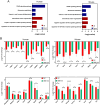A triterpene-enriched natural extract from Eucalyptus tereticornis modulates the expression of genes involved in adipogenesis, lipolysis, and extracellular matrix remodeling in a primary human and mouse cell line adipocyte
- PMID: 40382687
- PMCID: PMC12086905
- DOI: 10.1080/13880209.2025.2505443
A triterpene-enriched natural extract from Eucalyptus tereticornis modulates the expression of genes involved in adipogenesis, lipolysis, and extracellular matrix remodeling in a primary human and mouse cell line adipocyte
Abstract
Context: Obesity induces alterations in adipocyte size, tissue inflammation, vascularization, and extracellular matrix composition. Previous studies have shown that a leaf extract of Eucalyptus tereticornis Sm. (Myrtaceae), with ursolic acid, oleanolic acid, and ursolic acid lactone mixed with minor metabolites, provided a superior antiobesity effect than reconstituted triterpenoid mixtures in adipocyte cell lines and a pre-diabetic mouse model. Further identification of the molecular mechanisms of action of this mixture of triterpenes is required.
Objective: This study analyzes the effect of the natural extract and its components on early RNA expression profiles in human primary cultured adipocytes and a mouse cell line.
Materials and methods: RNA was sequenced using the DNBseq platform and the EnrichR software to perform gene enrichment analysis using the Gene Ontology database, Kyoto Encyclopedia of Genes and Genomes, and Reactome. To conduct clustering analysis, the normalized counts of each gene and applied k-means clustering were standardized.
Results: The combination of molecules in the natural extract has an additive or synergic effect that increases the number of genes regulated associated with the biological functionality of differentiating adipocytes, with UAL playing a central role. The natural extract modulates PPAR, Wnt, and Extracellular Matrix organization pathways significantly in both cellular models. Remarkably, the extract downregulates the expression of genes involved in lipid metabolism, adipogenesis, and adipocyte fat load, such as PRKAR2B, LPIN1, FABP4, Scd1, MC5R, CD36, PEG10, and HMGCS1.
Discussion and conclusions: Our study shows that Eucalyptus tereticornis extract is a promising option for treating adipocyte tissue dysfunction derived from obesity.
Keywords: Natural extract; adipocyte; adipose tissue; transcriptome; triterpenes.
Conflict of interest statement
The authors declare that the research was conducted without any commercial or financial relationships that could be construed as a potential conflict of interest.
Figures






References
-
- Balcazar N, Betancur LI, Muñoz DL, Cabrera FJ, Castaño A, Echeverri LF, Acin S.. 2021. Ursolic acid lactone obtained from Eucalyptus tereticornis increases glucose uptake and reduces inflammatory activity and intracellular neutral fat: an in vitro study. Molecules. 26(8):2282. doi: 10.3390/molecules26082282. - DOI - PMC - PubMed
-
- Betancur LI, Muñoz DL, Guillen A, Echeverri LF, Balcazar N, Acín S.. 2021. Major triterpenoids from Eucalyptus tereticornis have enhanced beneficial effects in cellular models when mixed with minor compounds present in raw extract. An Acad Bras Cienc. 93(Suppl. 3):e20201351. doi: 10.1590/0001-3765202120201351. - DOI - PubMed
MeSH terms
Substances
LinkOut - more resources
Full Text Sources
Other Literature Sources
Research Materials
